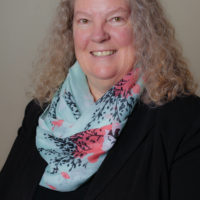Roland Quitugua, a leading scientist in the U.S. territory of Guam, stood before a room of 60 public school teachers, describing his tireless efforts to eradicate a devastating problem on the tiny island in the Western Pacific: the Coconut Rhinoceros Beetle.
Holding an embroidery hoop with a three centimenter black beetle stuck in the netting in one hand and a large pale grub in the other, Quitugua told the story of the human-rhino beetle conflict. This became the perfect model of how engineering design processes have been tried, one after another, in an effort to stop the invasive species from attacking coconut and other palms.
He described the series of failed attempts as simple, low-cost engineering designs: Buckets hanging from trees (which mysteriously disappeared and were found repurposed as fishing buckets); netting placed over loose soil (through which the beetles could crawl, unimpeded); fishing nets that successfully trapped the beetles (but worked so well they were taken for other uses).
Eventually, trial and error led to a design that worked: Netting with holes large enough for the beetles to crawl into but small enough to keep them from escaping. The netting is placed over the beetles’ breeding ground in organic waste piles.
Though the teachers had heard the scientist’s beetle story before, now they were looking at it through a new lens: creating place-based learning opportunities for students. Working together, the teachers designed live-animal traps with everyday items and explained how they would use them to capture particular animals. They discussed lesson ideas that would use the rhinoceros beetle story and projects to illustrate how STEM and the engineering design process are essential to solve local, unique problems in their communities. Ultimately, they were asked to think about how this story could inspire and empower students to design community-based STEM solutions for other local problems.
This is STEM as it is meant to be: motivating students and giving purpose to teaching and learning.
The teachers’ enthusiasm was palpable as they designed and compared traps while sharing animated stories of personal encounters with invasive species. Yet, we know from research that many STEM programs do little to engage students in STEM. Why? Because too often, what we do in the name of “STEM” is still “inside-the-box” learning.
Flipping the paradigm
Studies suggest that a major challenge to creating rich STEM learning opportunities is that teachers lack a “mental model” to draw upon as they envision what real STEM learning could look like in their classrooms (Bybee, 2013). As a result, much of what passes for STEM curricula remains superficial, rather than more engaging, rigorous cross-curricular opportunities.
Even STEM academies and other STEM-focused schools do little to improve achievement in STEM or spark student interest in STEM careers (Goodwin and Hein, 2014). For example, a study of 51 schools in Texas that were created to promote project-based learning in STEM found many of them were employing a traditional pedagogy that included explicit preparation for statewide tests (Young, House, Wang, Singleton and Klopfenstein, 2011). These schools were operating in a compliance mind-set and employing uninspired approaches to teaching and learning, said the researchers.
So how is Green STEM any different? Like most STEM programs, it uses project-based learning to provide students with opportunities to focus on real-world problems, develop solutions using evidence to support claims, and emphasize 21st century skills like cooperation, communication, and teamwork. However, Green STEM does this within the context of students’ own communities, challenging them to solve real problems that exist around them.
In essence, Green STEM aims to “flip” the paradigm for teaching and curriculum development by building not from the top down—asking what we want students to learn for the purpose of external assessments—but from the bottom up, asking what students want to learn and problems they want to solve.
This reflects the design principles of engaging curricula that Dennis Littky and Elliot Washor described in 1995 as “Big Picture Learning”: 1) learning must be based on each student’s interests and needs; 2) curriculum must be relevant to the student and allow them to do real work in the real world; and 3) students’ growth and abilities must be measured by the quality of their work and how it changes them (Littky and Washor, n.d.). Simply stated, Green STEM projects engage students with issues that matter to them, giving them greater motivation to learn.
Motivating schools to get started
Green STEM projects are intended to engage students with their local communities and are, therefore, not a program, curriculum or simple formula to follow. That said, there are few core principles and steps schools can take to develop Green STEM learning opportunities for their students:
- Identify a local green challenge: Finding the right problem(s) to solve is critical; students need to be able to investigate it through the engineering design process within the scope and time frame of the class. For example, the problem of excessive trash in the school is realistic because students can design a solution, take action and collect data to determine the effectiveness of the solution. Excessive trash in the town or state is too broad to address.
- Frame the challenges with driving questions: Research shows that simply doing a project does little to enhance student learning; it must have a clear focus or driving question. For example, “Why does the creek behind our school look and smell so bad?” This can lead to a series of water and soil tests to identify the problem; then, students can design and present solutions to water district authorities—who determine their viability.
- Ground all actions in STEM content: The key to making Green STEM projects different from environmental education or “green” activities is to frame all steps—from understanding the problem to implementing a solution—around STEM concepts.
- Provide choices for students: This can be difficult step for teachers—to “let go” of the learning process and give students some control over which projects to pursue and how to pursue them. However, research shows that students are often equally (if not more) motivated by having a limited set of choices (Goodwin, 2010). This is especially helpful with Green STEM projects, since some solutions are beyond the scope of experience and research of the students.
- Connect beyond the classroom: A key benefit of Green STEM projects is helping students see their positive impact in the world; therefore, those affected by the students’ actions should be included in the process. School families and neighbors may be surveyed to identify the problem and become a part of the solution. Community experts may become mentors and consultants; participating in “citizen science” projects can connect students to scientists and give them access to extensive data related to their local project. Teachers are instrumental in guiding the process of connecting with those outside of the classroom.
- Share the final results: This may be the most important aspect of Green STEM projects. Student motivation soars when they know they will be interviewing or presenting to others and that their decisions and actions will be seen and reviewed by someone for a greater purpose than a grade. A successful project is one in which students make sense of what they did and share it with those who have a stake in the problem and solution.
Well-designed Green STEM projects provide an opportunity for all students to say, we did it ourselves. By empowering them to work together to have an impact in the real world, Green STEM gives students greater motivation to learn and pursue STEM in college and beyond.
References
Bybee, R. W. (2013). The Case for STEM Education: Challenges and Opportunities. Arlington, VA: NSTA Press.
Goodwin, B. (2010, September). Research Says: Choice is a Matter of Degree. Educational Leadership, 68(1), 80‒81.
Goodwin, B., & Hein, H. (2014, December). Research Says: STEM Schools Produce Mixed Results. Educational Leadership, 72(4), 84‒85.
Littky, D., & Washor, E. (n.d.). Big Picture Learning [Brochure].
Young, V. M., House, A., Wang, H., Singleton, C., & Klopfenstein, K. (2011). Inclusive STEM Schools: Early Promise in Texas and Unanswered Questions. Washington, DC: National Research Council.
© Cognia Inc.
This article may be republished or reproduced in accordance with The Source Copyright Policy.
The information in this article is given to the reader with the understanding that neither the author nor Cognia is in engaged in rendering any legal or business advice to the user or general public. The views, thoughts, and opinions expressed in this article belong solely to the author(s), and do not necessarily reflect the official policy or position of Cognia, the author’s employer, organization, or other group or individual.


